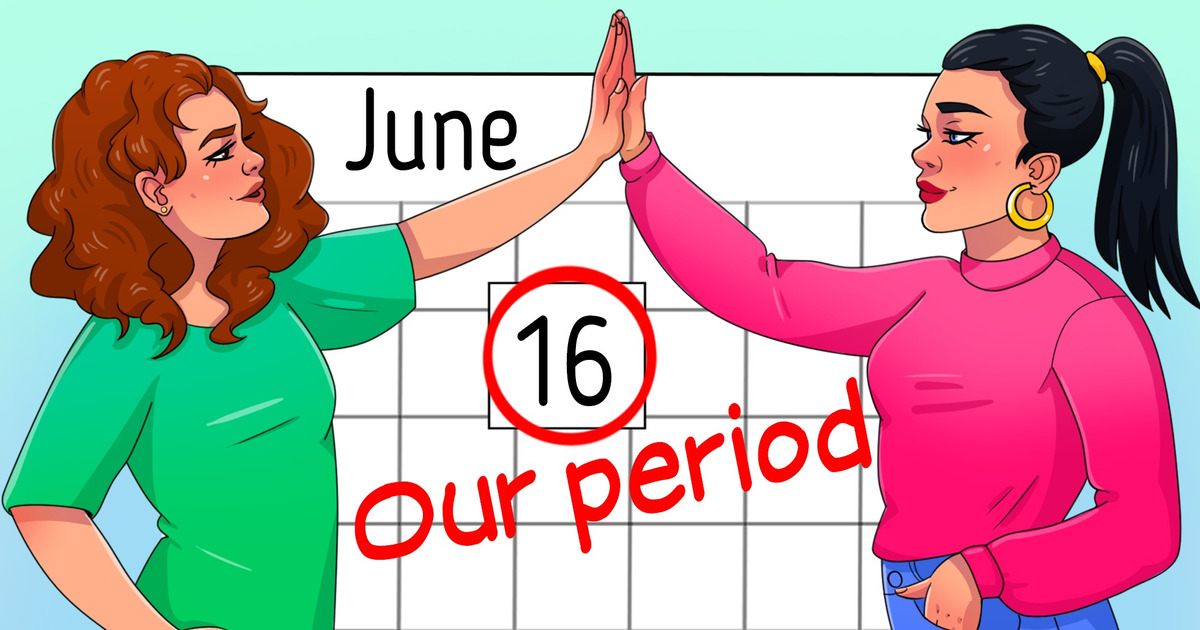The Truth Behind Period Syncing

If you’re a woman, you’ve likely heard the myth of how your period can become synchronized with another woman’s, or maybe you’ve even experienced this phenomenon yourself. Although this belief has passed from one generation to the next, research has shown contradictory conclusions about it.
5-Minute Crafts has created this article to explain what period syncing is and the science behind it.
What the theory says:

Also called “menstrual synchrony” or “the McClintock effect,” period syncing is a popular belief that states that women who share a home or spend plenty of time together will start their menstruation on the same day. This theory is supported by the idea that female pheromones affect each other when a woman comes in close physical contact with another woman who menstruates, which may result in lined-up menstruation cycles. Moreover, some women claim that “alpha females” can be an important factor when a whole group of women ovulate and have their period.
Although this belief is considered a real thing by women who menstruate, there’s no strong medical evidence to prove it. However, the theory has become so popular that different studies have tried to back it up.
What the evidence states:
The myth of period syncing has been around female communities for centuries. However, scientists didn’t consider the idea a serious thing until Martha McClintock, an American psychologist, analyzed 135 college women who were living together to find out if their cycles synchronized. The study followed when the participant’s monthly bleeding started, but it didn’t involve other menstruation aspects, like ovulation.
After the results, McClintock concluded that the menstrual cycles of this group of women were actually syncing up, which gave period syncing the name “the McClintock effect.”
Even though McClintock’s study proved the theory as a real thing, current research doesn’t show the same results. In fact, many people who have tried to duplicate her analysis have found methodological and statistical errors.
In 2006, a study stated that there was no period syncing among women after collecting information from 186 Chinese women who were living together in a dorm. Moreover, researchers claimed that if there appeared to be any evidence of period syncing, it was just a mathematical coincidence.
Moreover, a larger study analyzing data from more than 1,500 women concluded that it’s very unlikely that being close to each other can influence women’s menstrual cycles. This study was conducted by Oxford University alongside Clue, a company known for its period tracking app.
The conclusion:

Although it may seem like current research has come to a conclusion regarding period syncing, the truth is that we may never really know whether this phenomenon is true or false due to 2 main reasons:
- It can’t be said for sure if the pheromones that support the basis of period syncing can affect when a woman’s period begins. Here, it’s important to remember that pheromones are described as chemical signals that humans send to each other as an indication of fertility, attraction, and sexual excitement, among other things. Therefore, it’s difficult to know whether a woman’s pheromones could indicate to another that it’s time to menstruate.
- The logistics of period cycles among women make the theory hard to prove, as people experience menstruation differently. For instance, some women have shorter cycles than others, going through only 2 or 3 days of bleeding, while others will have 5 or 7 days of bleeding.
That being said, period syncing might usually happen as a probability matter rather than something else. For example, if a woman has her period for one week during the month, and she lives with 3 other female roommates, the probability is that at least 2 of them will have their periods together at the same time.
What can really influence your menstrual cycle:
While period syncing may still be a mystery, there are a few things that can influence your menstrual cycle. These are:
- Stress or anxiety
- Birth control pills
- Eating disorders
- Chronic illnesses
- Unbalanced diet during exercise


